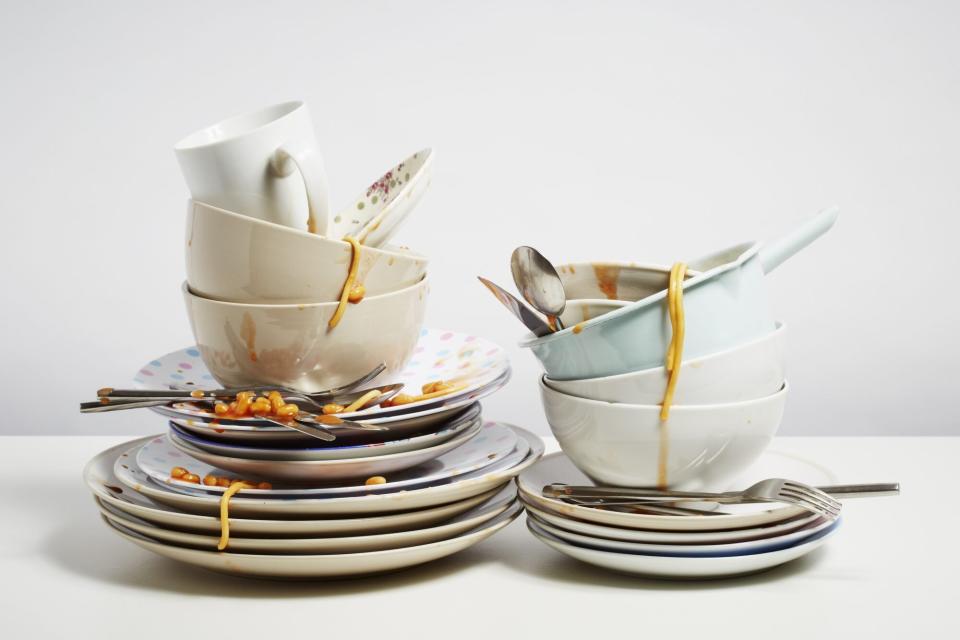How to Load a Dishwasher, According to the Pros

TABLE OF CONTENTS
On This Page
BOSCH: Scrape Don’t Rinse
MIELE: Stacking for Success
WHIRLPOOL: Keep Pans Out of the Way
WHIRLPOOL: Detergent Needs Vary
KITCHENAID: Let Plastics Air Dry
GE: There Isn’t A Right Way To Load a Dishwasher
VIKING: Optimal Drying Can Happen
Most of us know the basics, but in case you need a little refresher, the hard and fast rules for loading a dishwasher begin with the universal truth that all dishes should be loaded with the dirty side facing the jets. If you've been loading with all of your dishes facing the same direction, it's time to update the strategy.
You're probably well aware, though, that the dirtiest dishes should go on the bottom, while more fragile or lightly soiled items can go on the top. And of course, knives should be placed in silverware baskets with the handles facing up, while all other utensils should be placed with handles down. One last word of dishwasher wisdom: Never block the rotating arm. Never.
Now that we're all on the same page, let's get down to the lesser known facts for properly loading a dishwasher today (key word: today). Things aren't what they used to be and that pertains to our dishwashers too. As the machines have evolved over the years, so too have the proper techniques for loading.
Perhaps the most important thing to know is that there isn't one right way to load a dishwasher, but there are a great many ways to go wrong in between. To get down to the nitty gritty, lesser-known facts, we gathered the best tips from some of the top-rated dishwashing brands on the market.
BOSCH: Scrape Don't Rinse
Most modern dishwashers are well equipped to handle food remnants. In order to save on water, it's best to just scrape off dishes rather than rinsing before loading in the dishwasher. You know that old commercial where a platter with a layer cake is placed in the dishwasher and later comes out sparkling? We don't condone that, as it is a terrible waste of a perfectly good cake, but apparently there might be a bit of merit to it—though, once again, ill advised.
MIELE: Stacking for Success

PaulMichaelHughes/Getty Images
Miele is an industry leader in appliance design. In the case of their dishwashers, innovation means everything. When you consider how far this appliance has come, look to Miele. Their upper basket can be adjusted to three different levels, and additional side racks fold down to create extra room for cups and glasses. To make stacking even easier, Miele has color-coded all the elements that can be adjusted within the appliance. Does learning to load better involve buying a new appliance? You be the judge.
WHIRLPOOL: Keep Pans Out of the Way
I'm very guilty of this transgression: putting pots and large plastic cutting boards in the front of the lower rack, nearest the door. According to the pros at Whirlpool, this can block the detergent door, inhibiting the solution from making its way to the rest of the dishes. Yikes.
WHIRLPOOL: Detergent Needs Vary
My mind was yet again blown with this tidbit. The harder the water is in your location, the more detergent you'll need. Unsure of your water hardness? Go ahead and fill the dispenser about half way. It turns out that I've been overfilling my detergent for my entire adult life. Detergent needs will also depend on a variety of other factors including how soiled your dishes are, the detergent formula (powder, liquid, or pod), and other machine specifications.
KITCHENAID: Let Plastics Air Dry
If you've noticed plastic cups and utensils are still wet after the dry cycle, it might not be a user or machine error. Plastics are porous, which makes them dry slower that other materials. It's best to remove them from the dishwasher and let them air dry the rest of the way if needed.
GE: There Isn't A Right Way To Load a Dishwasher
If your husband swears his method for loading the dishwasher is the end all be all, we sure do hope he's reading this. According to GE Appliances, there are quite a few methods for correctly loading a dishwasher and perhaps even more methods for loading it incorrectly (see above).
VIKING: Optimal Drying Can Happen
Do you really need a rinse agent? Viking reminds us that this additive really does aid your load, in that it greatly improves drying, reduces spotting, filming and moisture left on the dishwasher interior. Remove the frustration of seeing your glasses come out spotty, making you feel like you need to wash them all over again.
Starting your dishwasher off on the right foot doesn't start and end with proper loading. Just before starting your unit, run the kitchen sink until the tap water is hot. It'll ensure your dishwasher begins the cycle with hot water.
Once you get your process locked down for loading, go through our best tips on what not to put in your dishwasher. You need to keep that kitchen friend in good condition!

